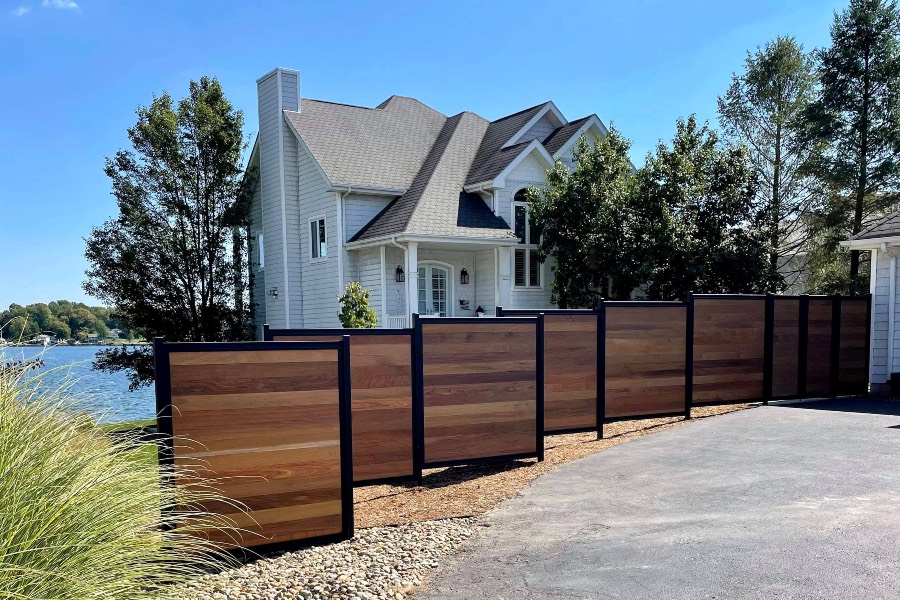All Categories
Featured
Fences play an essential role in providing personal privacy, safety and security, and improving the visual appeal of your residential property. However, continuous exposure to the aspects can bring about damage. From hefty rain and snow to extreme sunlight and wind, weather-related damage is one of one of the most typical causes of fence deterioration. While you can't manage the weather condition, there are several ways to shield your fencing from the harmful effects of climate and ensure it lasts for many years ahead.
Wood Fences: While wood fencings are a classic selection, they are extremely at risk to wetness and bugs. To make a timber fencing a lot more sturdy, select pressure-treated lumber, cedar, or redwood. These materials are a lot more immune to rot and pests. You'll still require to secure the timber from the components with routine maintenance.
Vinyl Fences: Plastic fencings are extremely sturdy and require little upkeep. They are immune to fading, cracking, and bending, making them optimal for regions that experience severe sunlight, rainfall, or cold weather condition. Plastic likewise won't rot or attract bugs, providing long-term security without the demand for consistent maintenance.
Steel Fences: Wrought iron and light weight aluminum fencings are outstanding choices for their strength and resistance to wind and wetness. However, they are prone to rusting over time, especially if revealed to frequent rains or moisture. Go with powder-coated or galvanized metal fencings to minimize the threat of corrosion.
![]()
Composite Fences: Combining wood fibers and plastic, composite fencings are resistant to decomposing, fading, and pest damages. They use the look of wood with less maintenance, making them an ideal choice for locations with variable weather.
![]()
Wooden Fences: A good high quality wood sealant or stain is important to safeguard your fence from the components. Be sure to reapply the layer every pair of years to keep your fencing in leading condition.
Vinyl Fences: While vinyl is low-maintenance, you can still secure it further by using a UV protectant. These finishes help protect against discoloration created by extended sunlight direct exposure. In addition, use vinyl-specific cleaners to keep the surface without discolorations or dirt build-up.
Metal Fencings: To protect metal fences from corrosion and corrosion, consider applying a rust-inhibiting primer followed by a protective paint created for outside use. Powder layer provides a long lasting and long-lasting surface that can stand up to extreme weather condition. if possible.
Wood Fences: Clean your wood fence with a stress washing machine or a soft cloth and mild cleaning agent. Check the fence regularly for indications of rot, fractures, or insect infestations.
Vinyl Fences: Vinyl fencings are easy to tidy with soap and water. For tougher spots, you can use a light bleach remedy or a plastic cleaner to bring back the fence's look. Don't forget to inspect for any type of splits that may let water in, resulting in further damage.
Metal Fences: Clean metal fences with a soft cloth to get rid of rust, dust, and dust. If you notice corrosion spots, remove them right away with a cord brush and deal with the location with a rust-resistant guide or paint to stop it from spreading.
Wooden Fences: When installing wooden fencing messages, make sure they are set deeply right into the ground, ideally below the frost line to stop changing during freezing temperatures. Use concrete to safeguard the blog posts and stop them from leaning or being uprooted by strong winds.
Metal Fences: For metal fences, make sure that the articles are securely anchored in concrete. This is especially crucial in areas with heavy winds or constant tornados. You may likewise intend to set up added bracing to offer extra assistance versus wind stress and anxiety.
Furthermore, excessive dampness from neighboring plants can lead to mold and rot in wooden fencings, so maintain greenery at a risk-free distance to enable proper air flow and water drainage.
Metal fences must be inspected for corrosion before the winter starts, and any type of influenced locations must be treated with rust-resistant items. Additionally, applying a layer of paint or safety finishing prior to the winter sets in can assist shield your fence from ice and snow damages.
![]()
Final thought. Protecting your fence from weather-related damage needs a mix of correct material selection, regular upkeep, and proactive care. Whether you have a wood, plastic, metal, or composite fencing, the appropriate safety actions can prolong its life-span and maintain its look. By complying with these easy yet effective steps, you can secure your fence versus the aspects and keep it looking terrific for several years ahead.
- Pick Weather-Resistant Materials. One of one of the most effective ways to protect your fencing is by picking the right product for your climate. Specific materials are much more durable and better matched to endure certain climate condition.
Wood Fences: While wood fencings are a classic selection, they are extremely at risk to wetness and bugs. To make a timber fencing a lot more sturdy, select pressure-treated lumber, cedar, or redwood. These materials are a lot more immune to rot and pests. You'll still require to secure the timber from the components with routine maintenance.
Vinyl Fences: Plastic fencings are extremely sturdy and require little upkeep. They are immune to fading, cracking, and bending, making them optimal for regions that experience severe sunlight, rainfall, or cold weather condition. Plastic likewise won't rot or attract bugs, providing long-term security without the demand for consistent maintenance.
Steel Fences: Wrought iron and light weight aluminum fencings are outstanding choices for their strength and resistance to wind and wetness. However, they are prone to rusting over time, especially if revealed to frequent rains or moisture. Go with powder-coated or galvanized metal fencings to minimize the threat of corrosion.

Composite Fences: Combining wood fibers and plastic, composite fencings are resistant to decomposing, fading, and pest damages. They use the look of wood with less maintenance, making them an ideal choice for locations with variable weather.
- Apply Protective Coatings. No matter the material, applying safety finishings is important in prolonging the life of your fence. Coatings create a barrier that guards your fence from wetness, UV rays, and other ecological stress factors.

Wooden Fences: A good high quality wood sealant or stain is important to safeguard your fence from the components. Be sure to reapply the layer every pair of years to keep your fencing in leading condition.
Vinyl Fences: While vinyl is low-maintenance, you can still secure it further by using a UV protectant. These finishes help protect against discoloration created by extended sunlight direct exposure. In addition, use vinyl-specific cleaners to keep the surface without discolorations or dirt build-up.
Metal Fencings: To protect metal fences from corrosion and corrosion, consider applying a rust-inhibiting primer followed by a protective paint created for outside use. Powder layer provides a long lasting and long-lasting surface that can stand up to extreme weather condition. if possible.
- Normal Cleaning and Examinations. Correct cleaning and routine inspections are vital to preserving the stability of your fence. Build-up of debris, dust, and mold can trap wetness versus your fencing and cause long-lasting damages.
Wood Fences: Clean your wood fence with a stress washing machine or a soft cloth and mild cleaning agent. Check the fence regularly for indications of rot, fractures, or insect infestations.
Vinyl Fences: Vinyl fencings are easy to tidy with soap and water. For tougher spots, you can use a light bleach remedy or a plastic cleaner to bring back the fence's look. Don't forget to inspect for any type of splits that may let water in, resulting in further damage.
Metal Fences: Clean metal fences with a soft cloth to get rid of rust, dust, and dust. If you notice corrosion spots, remove them right away with a cord brush and deal with the location with a rust-resistant guide or paint to stop it from spreading.
- Enhance Your Fence with Proper Setup. Correct installation is one of one of the most efficient methods to avoid weather-related damage. A fencing that is badly set up is most likely to collapse or experience damages throughout tornados.
Wooden Fences: When installing wooden fencing messages, make sure they are set deeply right into the ground, ideally below the frost line to stop changing during freezing temperatures. Use concrete to safeguard the blog posts and stop them from leaning or being uprooted by strong winds.
Metal Fences: For metal fences, make sure that the articles are securely anchored in concrete. This is especially crucial in areas with heavy winds or constant tornados. You may likewise intend to set up added bracing to offer extra assistance versus wind stress and anxiety.
- Trim Trees and Bushes Near Your Fence. Disordered trees and hedges can cause significant damages to your fence, specifically during hefty storms or high winds. Tree branches can scrape versus the fence, triggering scratches, and their roots can destabilize the blog posts. Maintain plants trimmed and make sure that tree branches are not leaning on or near the fence.
Furthermore, excessive dampness from neighboring plants can lead to mold and rot in wooden fencings, so maintain greenery at a risk-free distance to enable proper air flow and water drainage.
- Winterize Your Fence. Take additional preventative measures to safeguard your fencing from freezing temperature levels, snow, and ice if you live in a location with harsh winter seasons. For wood fencings, make certain the base of the messages rises above ground degree to stay clear of water build-up, which can fracture the wood and ice up. Consider utilizing a wetness barrier around the base of the messages to maintain them dry throughout the cold weather.
Metal fences must be inspected for corrosion before the winter starts, and any type of influenced locations must be treated with rust-resistant items. Additionally, applying a layer of paint or safety finishing prior to the winter sets in can assist shield your fence from ice and snow damages.
- Post-Storm Services. Tornados can cause immediate damages to your fence, consisting of dropped branches, busted posts, or dislodged panels. After each tornado, examine your fence completely to look for any type of visible damages. Address small problems rapidly before they come to be larger, extra costly repair services. It's a great concept to seek advice from a professional for repairs to guarantee it continues to be structurally sound. if your fencing has been severely damaged.

Final thought. Protecting your fence from weather-related damage needs a mix of correct material selection, regular upkeep, and proactive care. Whether you have a wood, plastic, metal, or composite fencing, the appropriate safety actions can prolong its life-span and maintain its look. By complying with these easy yet effective steps, you can secure your fence versus the aspects and keep it looking terrific for several years ahead.
Latest Posts
Why Choose NAPA AutoCare? Montclare Auto Repair Explains Why
Published Apr 21, 25
2 min read
Expert Mechanic Services at Montclare Auto Repair - Don’t Wait, Act Now!
Published Apr 21, 25
2 min read
Need a Service Center Locally? Choose Car-X St. Louis for Expert Care
Published Apr 21, 25
1 min read
More
Latest Posts
Why Choose NAPA AutoCare? Montclare Auto Repair Explains Why
Published Apr 21, 25
2 min read
Expert Mechanic Services at Montclare Auto Repair - Don’t Wait, Act Now!
Published Apr 21, 25
2 min read
Need a Service Center Locally? Choose Car-X St. Louis for Expert Care
Published Apr 21, 25
1 min read